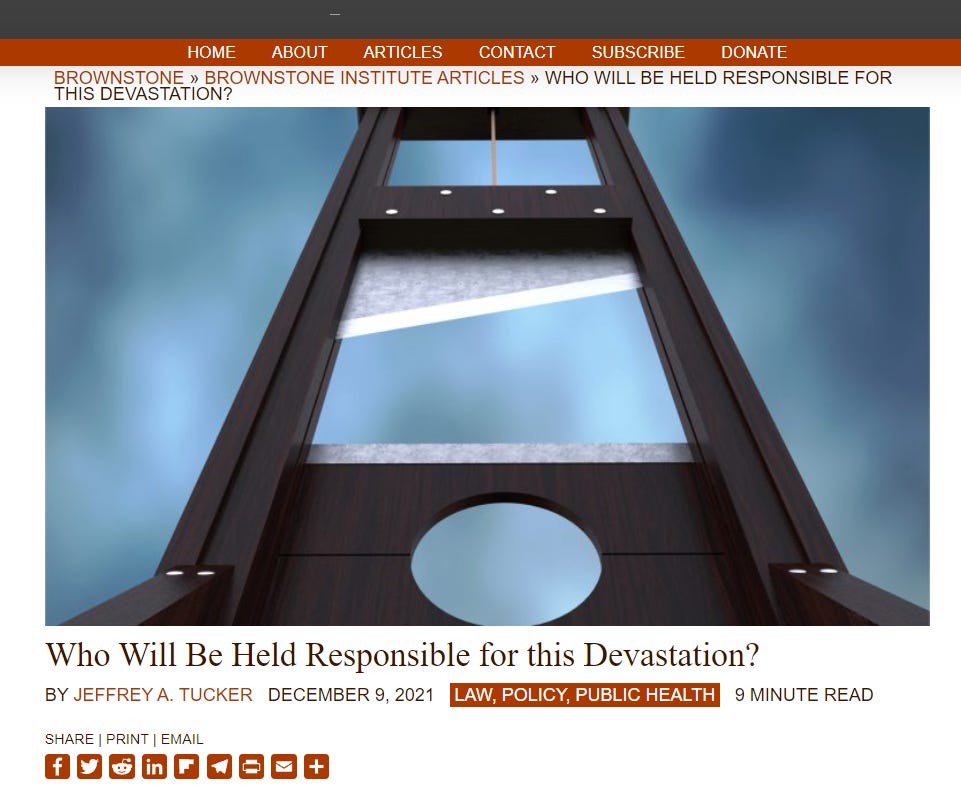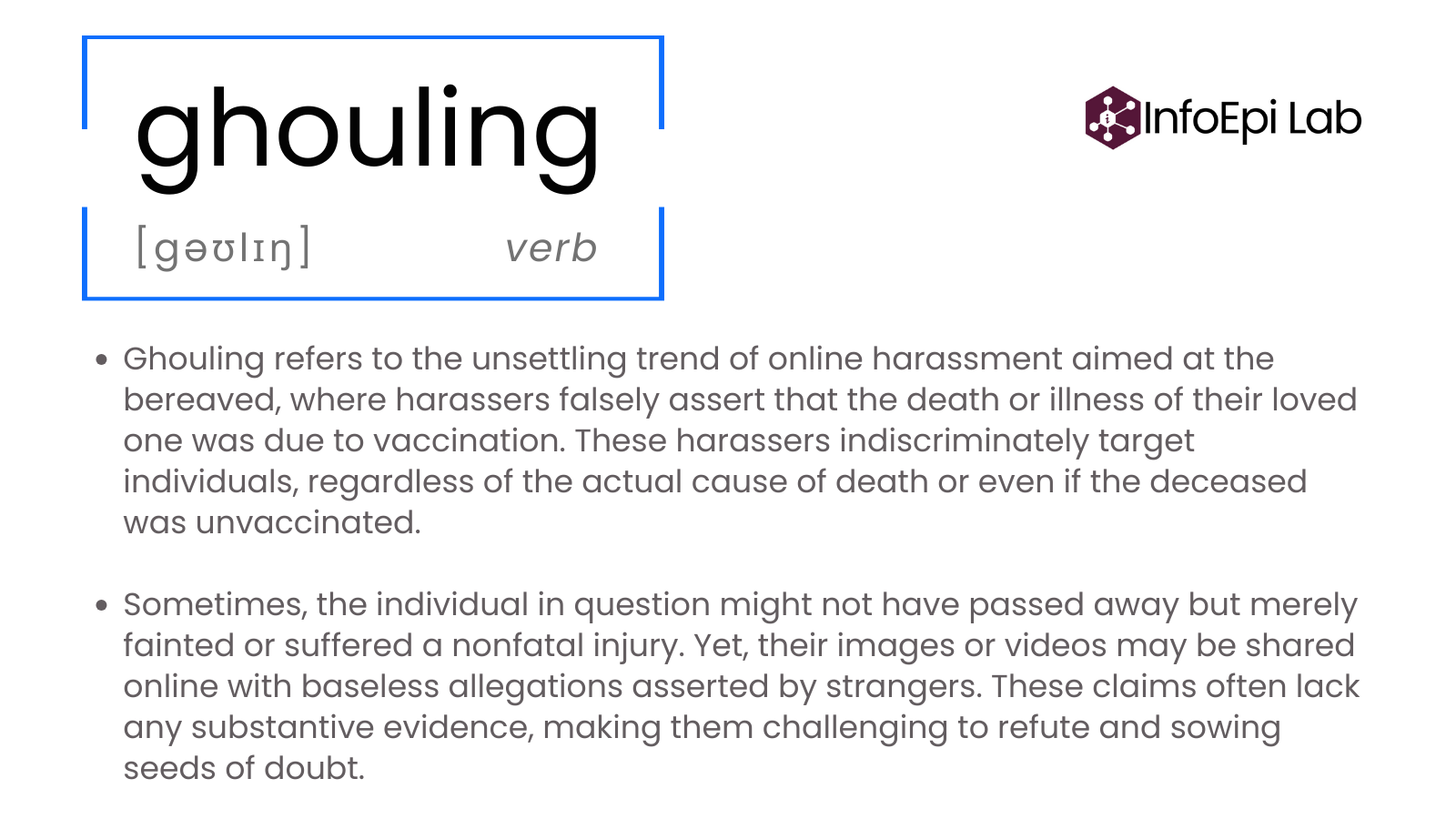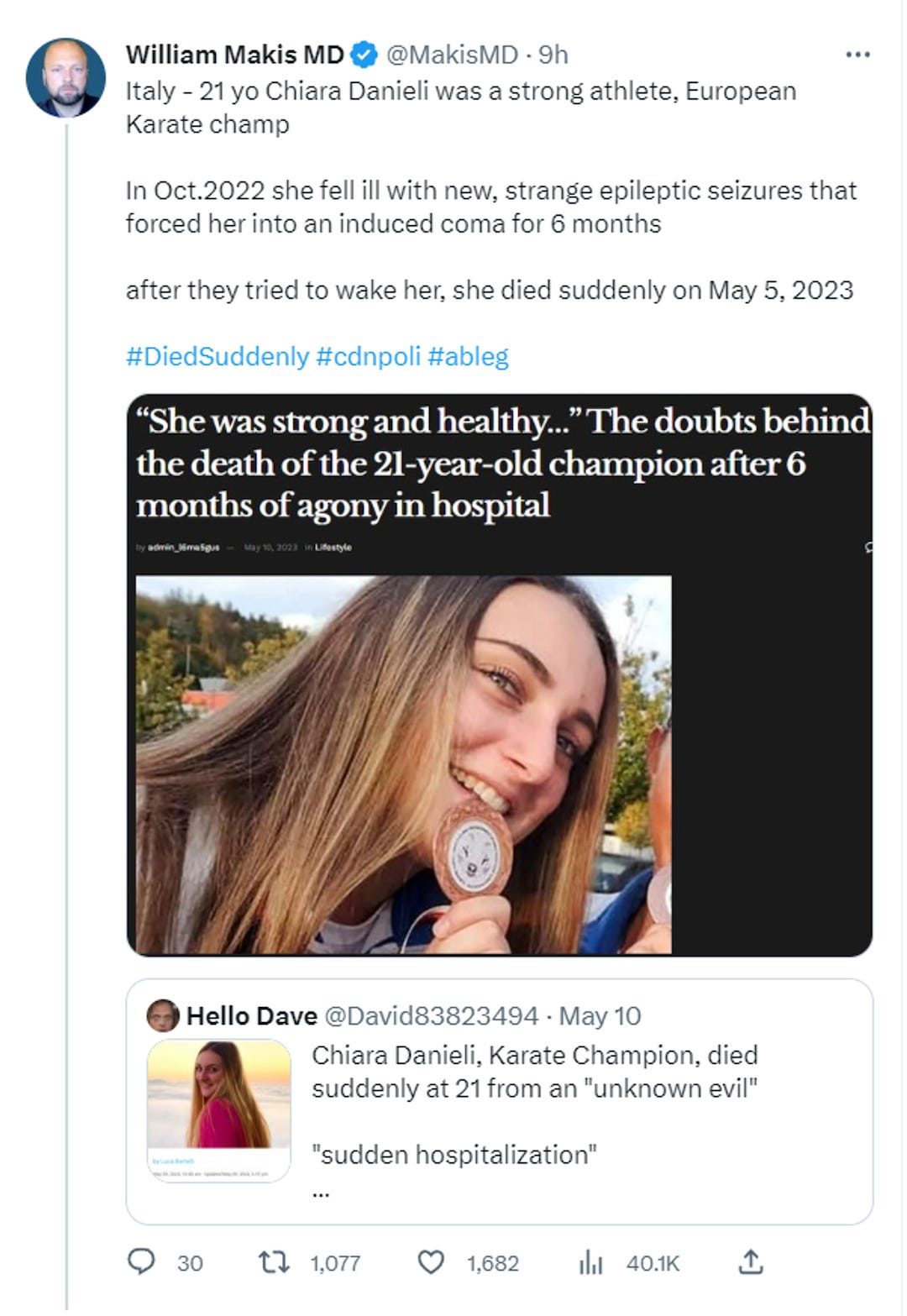On X, between October 7 and October 20, 2023, the user DiedSuddenly_ posted more high-performance tweets related to vaccines than any other account.
An earlier infodemic analysis found that “DiedSuddenly” was the top hashtag in May 2023. The data give no reason to hope that the practice of “ghouling” is going anywhere soon. With the ever-growing list of people that influential online figures claim have died from the vaccine–deaths that many anti-vaccine activists allege are the responsibility of people who recommended and gave them–the potential threat to public health and medical professionals may become more extreme.
An Unspeakably Cruel Trend
Ghouling refers to the unsettling trend of targeted harassment aimed at the bereaved, where harassers falsely assert that the death or illness of their loved one was due to vaccination. These harassers indiscriminately target individuals, regardless of the actual cause of death, amd whether the deceased was unvaccinated.
Sometimes, the individual in question might not have even passed away, merely fainting or suffering a nonfatal injury. Yet, their images or videos may be shared online with baseless allegations asserted by strangers. These claims often lack substantive evidence, making them challenging to refute and sowing seeds of doubt.
One person dies in the U.S. of a blood clot every six minutes, and that was the case before COVID-19.
Simply counting the number of athletes who died shows there hasn’t been an increase in sudden athlete deaths. When Politifact reviewed a list of athletes who allegedly died from the vaccine, they found multiple athletes hadn’t been vaccinated, and more critically, some hadn’t died.
Death totals reported show that sudden athlete deaths were the same or comparable to pre-pandemic numbers. Evidence supporting claims about athletes is rarely provided, but that can also make it harder to debunk, which may leave lingering doubt.
| Author | Frequency |
|---|---|
| DiedSuddenly_ | 55 |
| P_McCulloughMD | 40 |
| MakisMD | 31 |
| iluminatibot | 25 |
| VigilantFox | 25 |
| vivekagnihotri | 25 |
| kevinnbass | 21 |
| Inversionism | 20 |
| LeadingReport | 20 |
| TheChiefNerd | 19 |
| wideawake_media | 15 |
| bambkb | 14 |
| PeterSweden7 | 14 |
| ABridgen | 12 |
| JimFergusonUK | 12 |
| liz_churchill10 | 12 |
| Resist_05 | 12 |
| robinmonotti | 12 |
| DrLoupis | 11 |
| RWMaloneMD | 11 |
| stkirsch | 10 |
| IamBrookJackson | 9 |
| Cernovich | 8 |
| SHomburg | 8 |
| EricTopol | 7 |
Most popular hashtags from May 11 to May 17, 2023, globally
A Ghouling Case Study
An example of these refutation-resistant claims can be seen in the tweet about Chiara Danieli di Gavardo, who died at age 21. She was known for winning a gold medal at the 2019 European Championships in karate.
The family had not disclosed the woman’s cause of death, and multiple newspapers reported plans for an autopsy to determine the cause of her long-term illness. After her funeral, reporting indicated that she had an “obscure illness” for six months and that an autopsy confirmed the cause of death.
The claims were republished across a list of unreliable websites and, in some cases, foreign disinformation. The cemetery where Chiara Danieli di Gavardo was buried was subsequently vandalized with anti-vaccine messaging.
Despite reports at the time indicating the family and healthcare providers did not know what caused her death, her image was shared with the hashtag #diedsuddenly. The tweet author also has a popular Substack, COVID Intel, which had 16,000 subscribers and nearly 50,000 followers on Twitter in May 2023.
In under six months, that following has doubled, rising to 28,000 subscribers on Substack and 128,000 followers on X, formerly Twitter, by October 2023.
A recent report from the InfoEpi Lab shows that he was the third most influential author related to vaccines during a two-week period from October 7 to October 20, 2023. DiedSuddenly_ was the number one account with the most high-performance tweets. His publication catalogs sudden deaths, which he invariably concludes or implies were probably caused by vaccines.
Many of the people listed have an unknown cause of death or have a cause that isn’t vaccine-related. The lists of people who “died suddenly” frequently contain information that could encourage or be used to target families.
When a list of around 80 people alleged that these people had died related to the vaccine, the Canadian Medical Association reported that the database does not show any connection between vaccines and the deaths of medical doctors. Families indicated their loved ones had died from a list of common causes of death, such as heart attack, cancer, or suicide.
When a hospital posted about the death of a doctor who worked there, they had to clarify that the death was not related to the vaccine because the rumor had spread widely on social media. One reply reads, “Prove it.” Another says, “The sad part is, you’re not even allowed to find out if that was the cause!”
A critical aspect of these deaths that are falsely attributed to vaccines is they create a situation where believers may see justification for and even a dire need for them to respond with violence.
Calls for Violence Against Public Health Professionals
Another Substack, COVID News, had 35,000 subscribers in May 2023 and now has over 38,000, re-published a piece from COVID Intel about doctors who “died suddenly.” The author of COVID News is Paul Alexander, who served as a political appointee in the Department of Health and Human Services in 2020.
The COVID News and COVID Intel published the claim that Canadian doctors “push the toxic” vaccines, “presumably in exchange for a few pieces of silver.” They did not provide evidence for these claims or address more plausible explanations.
Important Context News reported earlier in 2023 on Alexander’s connections to the partisan think-tank Brownstone. In a piece published by Brownstone, Alexander “called to hang former director of the National Institute of Allergy and Infectious Diseases Dr. Anthony Fauci, former White House Coronavirus Response Coordinator Dr. Deborah Birx, and other public health officials in a post on his Substack.”
This was not the only current or former Brownstone author who seemed to call for violence.
 ](https://brownstone.org/articles/who-will-be-held-responsible-for-this-devastation/)
](https://brownstone.org/articles/who-will-be-held-responsible-for-this-devastation/)
In a December 2021 Brownstone article by the group’s founder, Jeffrey Tucker, which featured an image of a guillotine and called for “consequences” for public health officials and policymakers seeking to limit the spread of COVID.
The Tactics of Ghouls
The tactics used to target bereaved families resemble those used by followers of the #DiedSuddenly mockumentary. In an interview with the BBC, Stew Peters, the driving force behind the film, stated that he did not intend for people to be targeted. While one cannot argue with intent, the effect is another aspect entirely.
Research from Hoaxlines Lab in May 2023 showed that the activity of some of the biggest accounts claiming people died of vaccines without evidence began the same month Died Suddenly was released. It also coincided with a change of ownership at Twitter, now called X.
The targeting process may begin with people looking for evidence of a person’s vaccination status, despite a prior vaccination not being credible evidence of a connection or even a reason to suspect a connection. Still, stating the vaccination status implies meaning when these people are listed as dead in a post about people who allegedly died of the vaccine.
There are two distinct types of ghouls: those who create the propaganda and those who are manipulated by it and participate in the harassment. Helping the public understand the tactics used to manipulate their feelings means they can spot them “in the wild.” Here are some tactics commonly used:
Baseless accusations: These groups make unfounded claims linking the death or injury of a loved one to a specific cause, such as a COVID-19 vaccine. They exploit the lack of concrete information surrounding the cause of death to push the narrative, disregarding the actual medical facts. Sometimes, the family doesn’t know the cause of death themselves when the targeting starts.
Online harassment and verbal threats: Bereaved families are often subjected to alarming and distressing accusations. One woman reported she received messages that said she had killed her significant other because she encouraged vaccination. She reported that some even stated that she deserved her grief because of that encouragement.
Lying by omission: These groups cherry-pick cases of deaths or injuries that align with their agenda and falsely present the evidence to portray them as vaccine-related. Ghouls deny the underlying causes of death, such as pre-existing health conditions like cancer, accidents, or unrelated medical events. In some cases, the subject of the conspiracy theories hasn’t even died, as with Damar Hamlin.
Manipulation of emotions: The stories and emotional trauma of the bereaved families are put on display in online propaganda. The grieving families become the material for creating ideological propaganda. How effective the false claims are isn’t known, but we have cause for concern. Partially true claims can create some of the most compelling disinformation. The true parts lend credibility to the false claims.
On top of that, the increased familiarity with these claims from the repetitive campaigns online will likely increase the subjective impression of truth. Sound science is often disregarded in favor of terrifying, emotional stories. All of this works to cast doubt on the safety and efficacy of vaccines or other medical interventions.
Leveraging social media platforms: These groups use social media platforms to disseminate misinformation and reach a wider audience. They may use hashtags, create viral posts, or share videos to amplify their message and attract more followers who are susceptible to their narratives.
Exploiting gaps in knowledge: These groups exploit the general public’s limited understanding of complex medical issues and scientific research. They rely on misinformation, pseudo-science, and anecdotal evidence to fill these gaps and cast doubt on established medical facts. We call these data voids—it’s the absence of information. It’s easy to make an outlandish false claim about a virus or vaccine production when very few people know enough to understand what’s wrong with the claim.
Post hoc fallacy: They employ fallacious reasoning by attributing causality to the COVID-19 vaccine simply because a person had been vaccinated at some point. They ignore the extensive scientific evidence and rigorous studies that demonstrate the safety and effectiveness of vaccines.
Discrediting reliable sources: These groups often undermine the credibility of reputable sources, such as medical experts, scientists, and health organizations, by spreading conspiracy theories, questioning motives, or highlighting isolated instances of alleged wrongdoing.
Approaching the situation simply as false claims to debunk will not solve this. No one likes to be wrong. What people like even less is being manipulated.
For a debunking message to hit its mark, it should start by laying out the facts in an easy-to-understand manner. Don’t go into irrelevant details if your audience wants the general idea.
Then, caution the audience about the misconception, being careful not to reiterate the myth more than once. It’s crucial to pinpoint and unveil the deceptive tactics used to misguide people. Conclude by echoing the facts once again.
Citation
@article{li2023,
author = {Li, E. Rosalie},
publisher = {Information Epidemiology Lab},
title = {Ghouling, a {Trend} in {Unspeakable} {Cruelty}},
journal = {InfoEpi Lab},
date = {2023-10-30},
url = {https://infoepi.org/posts/2023/10/29-ghouling.html},
langid = {en}
}



